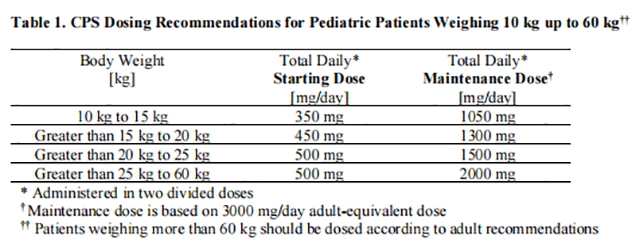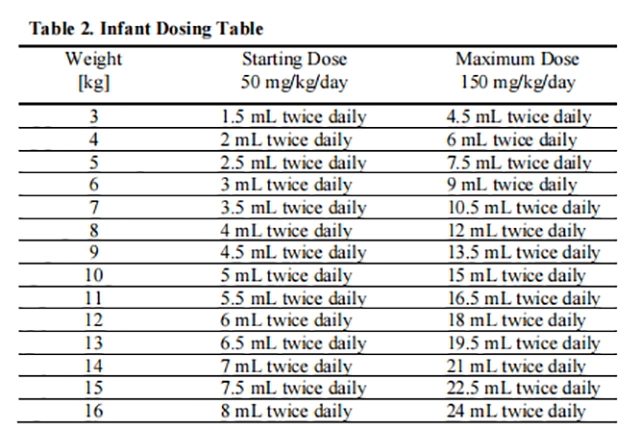Dosing
Use the lowest dosage and shortest exposure to Vigabatrin consistent with clinical objectives.
The Vigabatrin dosing regimen depends on the indication, age group, weight, and dosage form (tablets or for oral solution). Patients with impaired renal function require dose adjustment.
Monitoring of Vigabatrin plasma concentrations to optimize therapy is not helpful.
Administration
Vigabatrin is given orally with or without food.
Vigabatrin for oral solution should be mixed with water prior to administration. A calibrated measuring device is recommended to measure and deliver the prescribed dose accurately. A household teaspoon or tablespoon is not an adequate measuring device.
If a decision is made to discontinue Vigabatrin, the dose should be gradually reduced.
Treatment should be initiated at 1000 mg/day (500 mg twice daily). Total daily dose may be increased in 500 mg increments at weekly intervals, depending on response. The recommended dose of Vigabatrin in adults is 3000 mg/day (1500 mg twice daily). A 6000 mg/day dose has not been shown to confer additional benefit compared to the 3000 mg/day dose and is associated with an increased incidence of adverse events.
In controlled clinical studies in adults with complex partial seizures, Vigabatrin was tapered by decreasing the daily dose 1000 mg/day on a weekly basis until discontinued.
The recommended dosage is based on body weight and administered as two divided doses, as shown in Table 1. The dosage may be increased in weekly intervals to the total daily maintenance dosage, depending on response.
Pediatric patients weighing more than 60 kg should be dosed according to adult recommendations.

In patients with refractory complex partial seizures, Vigabatrin should be withdrawn if a substantial clinical benefit is not observed within 3 months of initiating treatment. If, in the clinical judgment of the prescriber, evidence of treatment failure becomes obvious earlier than 3 months, treatment should be discontinued at that time.
In a controlled study in pediatric patients with complex partial seizures, Vigabatrin was tapered by decreasing the daily dose by one third every week for three weeks.
The initial daily dosing is 50 mg/kg/day given in two divided doses (25 mg/kg twice daily); subsequent dosing can be titrated by 5mg/kg/day to 50 mg/kg/day increments every 3 days, up to a maximum of 150 mg/kg/day given in 2 divided doses (75 mg/kg twice daily).
Table 2 provides the volume of the 50 mg/mL dosing solution that should be administered as individual doses in infants of various weights.

In patients with infantile spasms, Vigabatrin should be withdrawn if a substantial clinical benefit is not observed within 2 to 4 weeks. If, in the clinical judgment of the prescriber, evidence of treatment failure becomes obvious earlier than 2 to 4 weeks, treatment should be discontinued at that time.
In a controlled clinical study in patients with infantile spasms, Vigabatrin was tapered by decreasing the daily dose at a rate of 25 mg/kg to 50 mg/kg every 3 to 4 days.
Vigabatrin is primarily eliminated through the kidney.
Information about how to adjust the dose in infants with renal impairment is unavailable.
•Mild renal impairment (CLcr >50 to 80 mL/min): dose should be decreased by 25%
•Moderate renal impairment (CLcr >30 to 50 mL/min): dose should be decreased by 50%
•Severe renal impairment (CLcr >10 to 30 mL/min): dose should be decreased by 75%
CLcr in mL/min may be estimated from serum creatinine (mg/dL) using the following formulas:
• Patients 2 to <12 years old: CLcr (mL/min/1.73 m2) = (K × Ht) / Scr
height (Ht) in cm; serum creatinine (Scr) in mg/dL
K (proportionality constant): Female Child (<12 years): K=0.55;
Male Child (<12 years): K=0.70
• Adult and pediatric patients 12 years or older: CLcr (mL/min) = [140 - age (years)] × weight (kg) / [72 × serum creatinine (mg/dL)] (× 0.85 for female patients)
The effect of dialysis on Vigabatrin clearance has not been adequately studied.
If using Vigabatrin for oral solution, physicians should review and discuss the Medication Guide and instructions for mixing and giving ABRIL with the patient or caregiver(s). Physicians should confirm that patients or caregiver(s) understand how to mix Vigabatrin powder with water and administer the correct daily dose.
Empty the entire contents of each 500mg packet into a clean cup, and dissolve in 10mL of cold or room temperature water per packet. Administer the resulting solution using the 3 mL or 10 mL oral syringe provided by the pharmacy. The concentration of the final solution is 50 mg/mL.
Table 3 below describes how many packets and how many milliliters (mL) of water will be needed to prepare each individual dose. The concentration after reconstitution is 50 mg/mL.

Discard the resulting solution if it is not clear (or free of particles) and colorless. Each individual dose should be prepared and used immediately. Discard any unused portion of the solution after administering the correct dose.
from FDA,2021.10